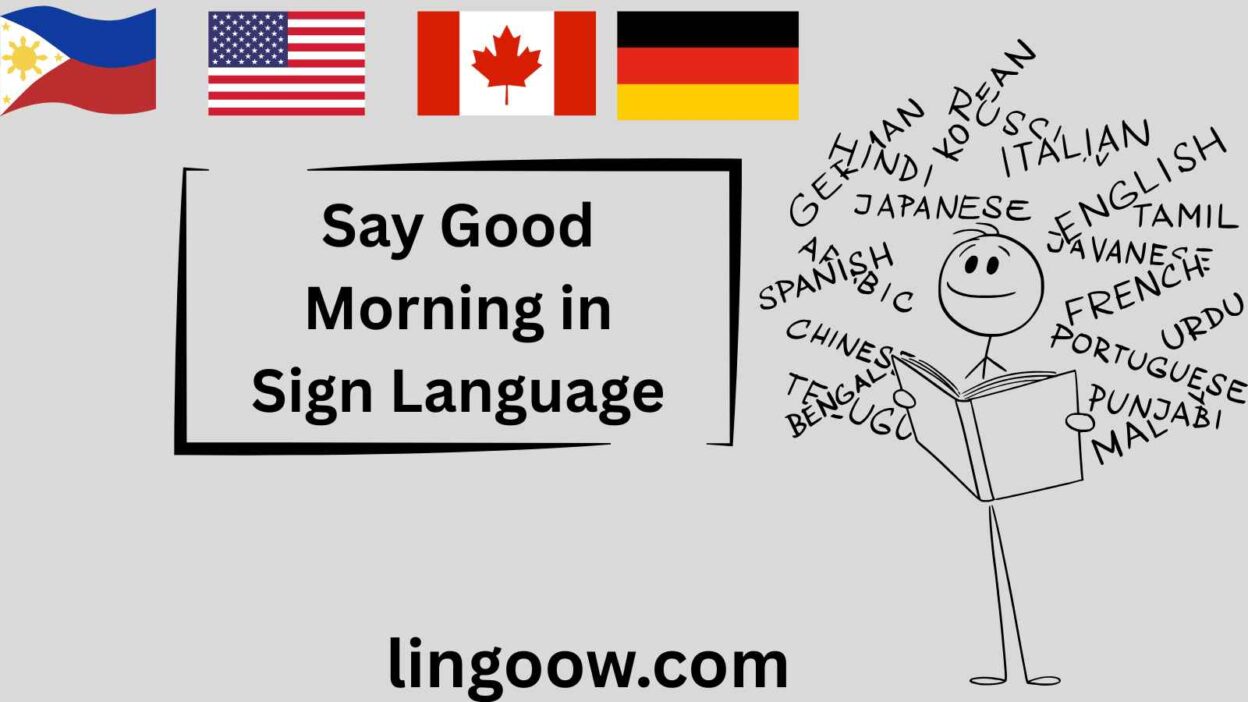Imagine this: The first rays of dawn peek through your window.
You turn to your deaf child, partner, or friend, and instead of words, your hands dance in the air—a universal gesture of warmth, hope, and connection. That simple “good morning” in sign language isn’t just a greeting; it’s a bridge across silence, a promise of a fresh start.
I’ve felt this magic personally—during a trip to a Deaf school in Kenya, a child’s beaming sunrise sign melted my heart, reminding me that no matter where we are, this phrase carries the universal theme of renewal and shared humanity.
Across cultures, “good morning” in sign language celebrates the sun’s rise, embodying optimism that speaks louder than sound.
Sign Language Morning GIF by Sign with Robert – Find & Share on GIPHY
Quick Reference Table
| Sign Language (Primary Country/Region) | Sign Description | Cultural/Linguistic Insight |
| ASL (USA) | Flat hand touches chin, moves forward to meet upturned palm (“good”); then arm horizontal, hand arcs up like rising sun (“morning”). | Emphasizes positivity in Deaf American culture; often used with a big smile to set a joyful tone. |
| BSL (UK) | Thumbs-up “good” near mouth; open hand arcs upward from lips (“morning”). | British Deaf community values polite greetings; reflects reserved yet warm etiquette. |
| Auslan (Australia) | Fist “good”; flat hand arcs up from elbow (“morning”). | Laid-back Aussie vibe—casual, sunny disposition mirrors the gesture. |
| NZSL (New Zealand/Maori communities) | Similar to Auslan: Sunrise arc with positive nod. | Blends with Māori hongi (nose touch) spirit for deep personal connection. |
| LSF (France) | Sunrise arc prefixed with “bon” (good) thumbs-up. | Romantic French flair; used in lively café Deaf chats. |
| DGS (Germany) | Hand near forehead sweeps up for sun; “gut” thumbs-up. | Precise, efficient—fits punctual German mornings. |
| JSL (Japan) | Open palm from forehead arcs out/up; subtle bow. | Reflects harmonious, respectful Japanese culture. |
| KSL (Korea) | Sunrise gesture with polite head tilt. | Influenced by Confucian bows—emphasizes hierarchy and respect. |
| ISL (India) | Dominant hand arcs up like sun from horizon. | Vibrant, communal; used in bustling Indian Deaf schools. |
| CSL (China) | Fist rotates near face for “morning sun.” | Collective harmony; mornings start with group greetings. |
| SASL (South Africa) | Expressive sunrise with clap for “good.” | Rainbow Nation energy—joyful, inclusive. |
| Kenyan Sign Language (Kenya) | Arm sweeps up; warm handshake follow-up. | Ubuntu philosophy: “I am because we are.” |
| NSL (Nigeria) | Bright sun arc with smile. | Communal village vibes; starts days with energy. |
| Libras (Brazil) | Playful sun rise + thumbs up. | Carnival spirit—lively and affectionate. |
| International Sign (Global events) | Universal sunrise arc. | Unites Deaf worldwide at Olympics, conferences. |
European Sign Languages
United Kingdom (BSL): Picture a crisp London morning. In BSL, your hand arcs gracefully from your lips, evoking the sun kissing the Thames. Brits sign it politely, often with “how are you?”—fostering that stiff-upper-lip camaraderie.
France (LSF): Bonjour le matin! The elegant arc mimics the Eiffel Tower’s gleam. French Deaf culture adds flair—pair it with a kiss on cheeks for vraie passion.
Germany (DGS): Efficient as a Berlin train: Forehead sweep + firm thumbs-up. Germans value Pünktlichkeit (punctuality), so this kickstarts structured days.
Italy (LIS), Netherlands (NGT), Sweden (STS): Variations on sunrise, but Italians add expressive faces, Dutch a direct nod—Europe’s diversity shines through shared roots from old LSF influences.
Asian Sign Languages
Asia’s vastness means unique flavors, from Japan to India, with Arabic Sign Language (ArSL) spanning UAE, Saudi Arabia, Egypt (20+ countries—dialects vary slightly).
Japan (JSL): Subtle palm sweep from brow + bow. Embodies wa (harmony)—imagine Tokyo commuters signing amid cherry blossoms.

“Good morning” Japanese Sign Language (JSL) with Explanation in International Sign (IS)
Korea (KSL): Tilted sunrise with bow—respect for elders first.
India (ISL): Bold sun arc; in diverse India, it unites Hindi, Tamil Deaf hearts.
China/Taiwan/Vietnam/Indonesia/Philippines + ArSL (Middle East): Sunrise dominates, but ArSL adds prayer-like poise in Muslim mornings. Over 20 countries share icons, adapted locally—proving signs evolve like silk roads.
African Sign Languages
Africa’s 54 countries boast 40+ sign languages! South Africa (SASL): Clap-sunrise for ubuntu joy. Kenya: Sweeping arc + hug—habari warmth.
Nigeria, Ghana, Uganda, Ethiopia, Egypt… Common sunrise, infused with rhythmic claps/drums. In Yoruba/Zulu influences, it’s communal—whole villages sign at dawn, echoing ancestral firesides.
Indigenous & Island Sign Languages
New Zealand (NZSL/Maori): Auslan-like arc + hongi essence—honors whakawhanaungatanga (kinship).
Hawaii (HSL): Sunny arc (rare now, blends ASL)—aloha spirit!
Cherokee/Native American: ASL-influenced sunrise; traditional hand talks revive morning prayers.
Samoa, Fiji, Inuit (Alaska/Canada), Aboriginal Auslan variants: Island arcs mimic ocean suns; 20+ Pacific/Indigenous groups emphasize earth connection—signs whisper to ancestors.
Cultural Insights
Signs for “good morning” evolved from iconic sun worship—ancient Egyptians gestured horizons, Romans too. LSF (1750s) birthed ASL; JSL from 19th-c. missionaries. Rooted in religion (Islamic dawn prayers in ArSL), history (post-colonial blends in Africa), they symbolize resilience—WWII Deaf hid signs, now they unite globally.
Famous Proverbs & Sayings Signed Around the World
- ASL (USA): “Rise and shine!” (Sun arc + sparkle hands)—new day, new you.
- BSL (UK): “Every morning is a fresh page” (Book open + sun).
- JSL (Japan): “Morning sun clears the mind” (Sweep + clear face).
- SASL (Africa): “Ubuntu dawn: We wake together.”
- ISL (India): “Subah ka suraj, nayi umeed” (Sun = new hope).
FAQs
Why do signs look similar worldwide? Iconic! Sun rising is universal—biology trumps borders.
Oldest known usage? Prehistoric gestures; documented in 18th-c. Europe.
Cultural differences? Asia: Bowing respect. Africa: Communal claps. Europe: Precise. Islands: Nature-infused.
Conclusion
From New York’s hustle to Nairobi’s markets, “good morning” in sign language pulses with emotional power—a silent symphony of hope. It reminds us: We’re one human family under the same sun. What’s your “good morning” sign? Share in comments, practice ASL today, or tag a friend to learn together! 🌅✋ Let’s spread the light!
Follow for more cultural sign adventures.




